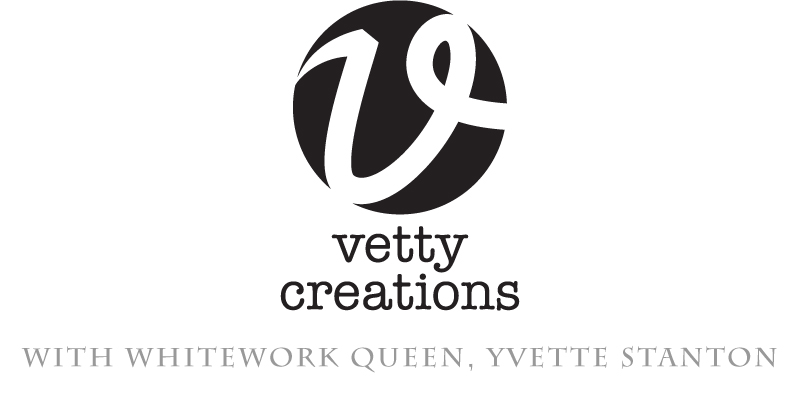


 |
 |
 |
|||

|
|
|||||
 |
|||||
What is Mountmellick embroidery?
The stitches of Mountmellick embroideryMountmellick embroidery is highly textured with many knotted and padded stitches used. Part of the fun of working Mountmellick embroidery is playing around with the stitches and working variations of them. On some historical examples of Mountmellick, there were only a limited number of stitches used. However, due to all their variations, the effect produced was highly patterned and varied. There are a number of stitches that are regarded as unique to Mountmellick embroidery:
The Mountmellick knitted fringeMountmellick embroidery is traditionally edged in buttonhole stitch (often in scallops) to which a knitted fringe is attached. It is made using an ingenious method to create the fringe. Many times I have demonstrated the technique at needlework and craft shows, and the most common response is for people's jaws to drop open when they see how simple the fringing is! The lace section of the knitting has thick ridges contrasting with lines of more open knitting. The ridges and open parts are created by increasing and decreasing stitches during the knitting process. There are a number of different patterns that can be used to create the Mountmellick knitted lace/fringe. 3 or 4 strands of yarn are used together, which gives it its fullness. We have created a video tutorial of how to create the Mountmellick knitted fringe - method No 2 as shown in "Mountmellick Embroidery: Inspired by Nature". Mountmellick embroidery for todayMountmellick embroidery is highly suitable for use in the contemporary home. Although it is white, it can be used on many items of daily household use, as it can easily be boiled white again. Because it is so sturdy, the embroidery holds up well to this treatment. Mountmellick embroidery is suitable to be used on:
It is because of the sturdiness of both the stitches and fabric, that there are so many surviving examples of Mountmellick embroidery. Those that have not survived to the present day are more likely to have fallen victim to changing fashions, rather than wear and tear or moths. The present revival began in the 1960s when Sister Teresa Margaret McCarthy of the Mountmellick Presentation Convent began to investigate the style. Based on the historical examples that were shown to her, she taught herself the style and began to teach others. Sr Teresa is highly respected and is credited with being the driving force behind the revival. Learning Mountmellick embroideryVetty Creations provides a number of ways to learn Mountmellick embroidery:
Where to see Mountmellick embroideryVisit Yvette's Mountmellick Embroidery Pinterest page for clickable, visual links about Mountmellick embroidery. Around the world you can find examples of Mountmellick embroidery within museum and guild collections. It is always wonderful to see the real thing! You gain a real appreciation of the texture, feel and appearance of the work, that you just can't get from books or webpages. If there is any way you can visit some of these places, I would encourage you to - what you will learn from seeing the real thing is priceless. At most, if not all of these institutions the Mountmellick articles are not on display. You should always contact the curator first, and if necessary make an appointment to view the work. It would be very disappointing to miss out because they simply did not know you were coming. You may need to make arrangements many months beforehand, so plan ahead! It is unlikely that you will be able to touch the pieces, but the supervising curator may be able to show you what you would like to see. If you know of other public or guild collections that include examples of historical Mountmellick embroidery, I would love to hear about them. More contemporary (i.e. worked after 1960) Mountmellick embroidery, while beautiful, is not the focus of these listings. Australia The Museum of Applied Arts and Sciences (Powerhouse Museum)
The Embroiderer's Guild of Victoria
The Embroiderer's Guild of Queensland
"Meroogal" Historic Houses Trust
Europe The Victoria and Albert Museum
The Ulster Folk and Transport Museum
The National Museum of Ireland
The Religious Society of Friends (Quakers)
An Grianan Adult Education College
Mountmellick Development Association Museum
Mountmellick embroidery suppliesBecause Mountmellick embroidery is an historical style of embroidery, materials as close to the traditional ones should be used. Our page on Mountmellick embroidery supplies provides more detail on what to use and where to get it. Vetty Creations has a full range of Mountmellick embroidery supplies, including thread, fabric, knitting cotton, needles and kits, available for purchase. Purchase Mountmellick embroidery supplies. Further reading about Mountmellick embroideryFor further reading on the subject, we have provided a handy listing of Mountmellick embroidery books. While some are out of print, they may be available through public or needlework guild libraries, or from second-hand bookshops. |
Purchase your copy today! This book is a delight, visually and technically. These fine Australian embroiderers have given us an inspiring book with well designed, varied projects using clear concise instructions. Their Mountmellick history section is informative, their stitch guide practical and accurate. It is with much pleasure that I recommend this creative book to all dedicated Mountmellick embroiderers and to those who, at last, have a book to lead them into the fascinating world of Mountmellick. --Deborah Love, Mountmellick Tutor, Embroiderers' Guild Queensland |
||||
|
|
|||||
| Copyright © Yvette Stanton 2001-. All rights reserved. | |||||